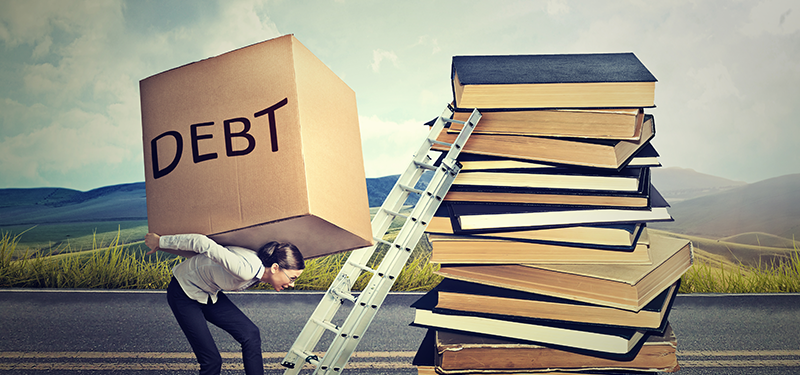Pay off Debt Head-on!

Having too much personal debt can be tough to deal with. Financially it can feel as if you’re on a never-ending treadmill of payments. And it’s not just the financial impact of debt that can be burdensome, but having too much debt hanging over you can lead to feelings of anxiety, embarrassment, shame, and depression to name just a few. And a little known fact, you can even be doing a great job in making the agreed upon payments to your creditors, but having that debt will still hurt your credit score. Approximately 30% of your credit score is associated with a consumer’s level of debt.
With all of the negative financial, emotional, and credit impacts it’s obvious that one should get out of debt as efficiently and quickly as possible. But unless you hit the lottery, there’s no real quick fix for turning things around. Reducing personal debt takes being realistic, having a good plan, being disciplined, and some time.
Here are some good fundamental steps that we recommend for getting out of debt.
Deal With Debt Head-on
When looking to get rid of debt it’s important to face it directly and acknowledge that you have an issue that it needs to be addressed. Too often people will continue to spend and live their lives as they have been normally, which will often make the situation worse. The longer you put off making the changes necessary to reduce debt the more you’ll pay in total finance chargers, and the longer you’ll be living with the anxiety not dealing with debt can cause. By acknowledging it and beginning to take action to improve things, you’re taking control of you life – which can feel extremely empowering.
List Your Debts
Next, list out all of you debt obligations. This should include everything – credit cards, personal loans, student loans, auto loans, etc. Include your current total balance for each, what the monthly payment is, when it’s due each month, and what you annual percentage finance charge is for each.
If you’ve not laid out all of your debt obligations in a form like this before it might be a little overwhelming initially. But this is a necessary step on getting a handle your current debt situation. Also, this information will be used to help develop your plan for getting rid of debt.
Lower Rates
One of the things that makes bringing down your debt tough is that with finance charges you’re always “swimming up stream” against the effect they have on your debt. Each month you’re in debt is also another month of mounting finance charges. And this effect can be much worse the higher your finance charges.
The website The Balance provides an interesting example illustrating the impact percentage finance charge can have on your debt.
10% Finance Charge
With your $400 monthly payment on balance of $20,000 with an APR of 10% $233 goes to principle, $167 goes to interest. It will take you 5 ½ years to pay of your debt, and during that time you will have paid $5,980 in finance charges.
20% Finance Charge
But, with an APR of 20%, your monthly payment of $400 only $66 goes to principle and $333 goes to finance charges. It will take you 9 years to pay off your balance, and during that time you’ll pay a staggering $23,360 in finance charges!
So one key to reducing your debt as quickly as possible is to focus on reducing your interest payments. Two primary ways to do this are focus on your highest interest debts first, and see if you can negotiate a lower finance rate with your creditor.
In targeting which debts get the highest priority we’ll use the list of debt items we developed initially. Part of that list included the finance charge for each item, which can often be a wide range of percentages.
Getting your creditors to reduce their finance rate charge is a little bit of a long shot, but it’s worth trying. The worst thing that can happen is they say no, and you’re no worse off than you were before. But if you’ve got a good payment history there is a much better chance of getting some reduction.
Make A Plan
By making a plan we want to look at our debt in conjunction with our personal budget. First list your monthly income from all sources, and then below that all of your monthly payments. This should include all of your personal expense – groceries, utilities, entertainment, and all of your monthly debt payments to things like credit cards, student loans, etc.
Next, and this is the tough part, ask yourself where can I cut? If you’re currently spending $50/week on entertainment, can you get away with $25/week or less? If your food expense is $100/week, can you pack a lunch for work rather than going out? These aren’t fun choices, but it’s this kind of belt tightening that will help get out of debt as quickly as possible.
Finally, with the additional money from your cutting, look at which debts you’d like to pay off first due to having the highest interest rates and allocate that money to them first.
Again, none of this is fun. But going through this process is one of the best things you can do for yourself when it comes to your personal finances. Debt has the effect of strangling out your ability to save and invest for the future. Tackling it head on with a good plan is the best way to have debt be a part of your past and not your future.





